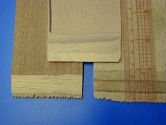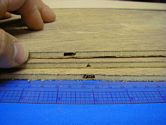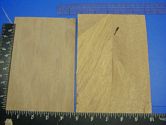
| INDEX | next >> |
 |
|
About "Stitch & Glue" PlywoodThe vast majority of stitch and glue kayaks is built from 'Marine plywood' which is overall an excellent choice but marine plywood is generally limited to only a few unimpressive looking wood species and predictably, kayaks built entirely from such material do look accordingly. After all, many S&G kayaks are painted to hide the wood. Marine plywood is made to certain specifications so it is of predictable quality and as a result, has been adopted by and large as the only 'acceptable' and 'safe' material for stitch and glue kayaks. This is certainly understandable since confusion and mystery surrounding marine plywood abound and 'kit biz' interests are quite happy to perpetuate this orthodoxy.So, what is this stuff ?! Marine plywood has actually less to do with the wood itself as it has with the specifications to which it is manufactured. Let's look at the 'wood' first. The vast majority of marine plywood in the world is made from the Okoumé (Acuomea Kleinea) tree which is harvested in the African state of Gabon in the tropical forests of the Congo Basin. This wood is also often referred to (correctly or not) as Gabon, Gaboon, Okume, Ocume, Ocoume, BS1088 etc. and the plywood core as well as the skins are made of the same wood. Virtually all Okoume plywood is manufactured outside of the US and Canada so it is a good bet that the plywood in your kayak will likely come from some factory in greater Asia, Israel, France or Greece. Another less common variety of marine plywood is 'Meranti'. It is made from many subspecies of the 'Shorea' tree species which also happens to be the source of wood for the common Lauan (luan) plywood. Both Lauan and Meranti plywood are also referred to interchangeably as Philippine Mahogany and the wood is harvested in Indonesia and the South Pacific rim forests. Now, there is also White Lauan made from Shorea almon, Red Lauan made from Shorea negrosensis which happens to be the Red Meranti. Other 'Meranti' plywood is made from Shorea curtisii, S. hypochra, S. leprosula, S. multiflora, S. platiclados, S. pauciflora to name a few. Confusing enough ? Marine plywood is also made from Fir, Ash, African Mahogany (Kaya), Honduras Mahogany and/or combinations of Okoume core with Sapele, Teak as well as other wood skins but those are largely used on plywood thicker than 4mm which is unfortunate - for kayak builders. The look of marine
plywood is not only determined by the wood species but it can also vary
according to the ply cutting methods. The most common is rotary cutting
which give the plywood surface a look of 'contours' on a topographical
map (same look as common plywood in a lumber yard). The other method
of cutting is 'quarter sawn' slicing which produces nice 'ribbon' look
with the tree growth rings appearing as parallel lines (like wood strip
kayaks). The immediate implication of this is that building your kayak
with the 'same'
type of marine plywood as your friend built a year ago may make your
kayak look quite different (color and texture wise). The plywood will
have likely come from a different lot of logs and/or subspecies. Also,
Meranti plywood is less available in thickness less than 1/4" (6.2mm)
and is largely heavier due to the wood density itself as well as additional
glue since it comes in 5 ply. Okoume plywood under 4mm is always made
in 3 plys. A 4' x 8' sheet of 4mm Okoume can range from 12 to 16lb ($30-50
price range) and Meranti about 19 to 24lb. All in all, you will be hard
pressed to find anything lighter than Okoume. The last and most important point that deserves consideration is the requirement for a void free core. This is a structural issue and large voids or cracks in the core essentially reduce the thickness of the plywood in that area to the sum of 'thickness' of the skins and the fiberglass. So if you have 6mm Lauan on the hull with a huge crack in the core, the actual thickness of the plywood becomes about 3/32" (2.5mm) which is very bad! BS1088 and BS6566 plywood will guarantee a completely solid core but it doesn't mean that it is the only plywood in existence that has it. If you look around, you will find a vast amount of excellent quality plywood on the market which uses the same glue as BS1088, and even if it doesn't, the core and skin will be as solid, perhaps better than any BS 6566 plywood. If you decide to build from non marine plywood, make sure to examine the sheets from the side (perpendicular to the grain orientation of the skins) to verify the quality. In my experience, top quality exotic veneers (which is what we like in our kayaks) are not bonded to crappy cores so the plywood sheets will generally be consistent with the overall quality and price of the veneer. So far, this gives us a decent selection but if you want something really special you can also make your own plywood by bonding veneer (of which there is even larger variety) dierctly to 3mm or 4mm plywood. To do this right, however, will require vacuum bagging or veneer press since the gluing will need to be done with slower setting adhesives such as Titebond II or epoxy. Some plywood merchants also provide this customized service. So, if you are building the Cirrus, Okoume and Meranti plywood are not your only choice and that's no 'BS'. |
 |
Scarf
gluing and sanding veneer plywood is always more difficult since
the veneer is very thin and will not tolerate sloppiness in sanding or aligning
and gluing of the scarfed sheets. As you can see from the Sapele sample
on the left, the margin on the veneer is quite small. If you are going to
build One Ocean Kayaks Stitch
& Glue Kit, the scarfing is avoided with the special ScarfLOCK
joint. The Okoume (center and right) as well as any thicker skinned plywood will be far more tolerant of sanding or misalignment. Veneer thickness is about 0.5mm and less while the skins on Okoume are about 1mm and more depending on the overall plywood thickness. |
 |
Ouch! Nice core voids in the 6mm Luan (Lauan). This is definitely not going into my kayak! It is possible to find very good Luan but it's more a matter of luck than anything else. Since the grain orientation of the skin will likely go along the length of the kayak plates, the grain direction of the core (and any voids) will run perpendicular, which will be fortunately visible on the sides of the narrow kayak plates. It is doubtful that a core void will start and terminate within the 'width' of the plates which are at the largest span about 10" wide. When you do a quality check on your kayak plates, these flaws will be unmistakable and such plates cannot be used. That is the compromise of using cheap material. |
 |
Cheap 1/8" Lauan on the right shows grain runout that required patches on the entire sheet. Nothing like the right piece should ever end up in your kayak - not that you would put it in. The left piece is luan too but significantly better. |
| INDEX | next >> |
| 1 2 3 3a 3b 4 5 6 7 8 9 10 11 12 13 14 |
| Home | Kayak Designs | Kayak Shop | Materials | Kayak Gallery | About us |
| Building Manual | Plans | Sandwich Core | Wood Kayak | Order | |
| Epoxy Test | Abrasion Cloth | Rudder | Resources | Choosing Kayak | Guestbook |
If you notice any problems with the site (i.e. error links, missing images) please, let me know. Thanks
Mail:
Vaclav Stejskal
10 Colonial Court apt. 73
Stoneham, MA. 02180
USA
Tel: 781-481-9261
© 1999
- 2020 Copyright Vaclav Stejskal
All rights reserved
Last page update:
11 January 2020